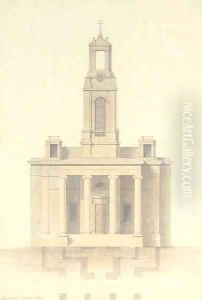Lewis Vulliamy Paintings
Lewis Vulliamy was an influential British architect known for his contributions to 19th-century architecture. Born on March 15, 1791, in London, England, Vulliamy hailed from a family with a strong artistic lineage; his father, Benjamin Vulliamy, was a renowned clockmaker to King George III. This environment nurtured his early interest in design and architecture, leading him to pursue a career that would see him leaving a lasting impact on British architectural history.
Vulliamy's education and early career were marked by his dedication and passion for architecture. He trained under the tutelage of Sir Robert Smirke, a prominent architect of the time, best known for his work on the British Museum. Vulliamy's talent and hard work were recognized early on when he won a silver medal from the Royal Academy in 1818 for his architectural drawings. This accolade helped to establish his reputation and launched his professional career.
Throughout his career, Vulliamy was known for his eclectic style, incorporating elements of the Greek Revival and Italianate styles, which were popular during his time. One of his most notable works is the Swiss Cottage in Caversham Park, which showcases his ability to blend architectural styles harmoniously. He also made significant contributions to urban planning and was involved in the layout of several districts in London.
Despite his contributions to architecture, Vulliamy did not gain the same level of fame as some of his contemporaries, such as Augustus Pugin or John Nash. However, his work was respected by his peers, and he held various prestigious positions, including being a fellow of the Royal Institute of British Architects. Vulliamy's legacy lives on through his buildings and in the influence he had on the architects who followed him.
Lewis Vulliamy passed away on January 4, 1871. His death marked the end of a career that had spanned over five decades, during which he had made significant contributions to the field of architecture. Today, Vulliamy is remembered not only for his architectural achievements but also for his role in the development of the architectural profession in Britain during the 19th century.
